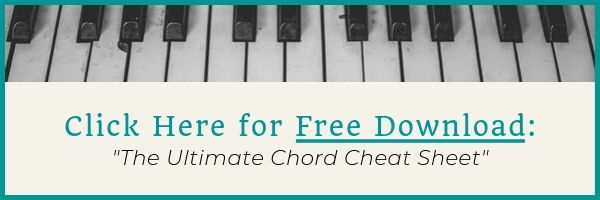The Eb7 Piano Chord: A Comprehensive Guide
Ready to learn the Eb7 piano chord? Eb7 is an interesting and versatile chord that can add depth and richness to your playing. It is known as a dominant 7th or sometimes just 7th chord and has both major and minor qualities combined into it.
With just a touch of music theory, some practice, and a healthy dose of curiosity, you'll be mastering this intriguing chord in no time. So sit comfortably, stretch those fingers, and let's learn more about this chord.
The Basics: What are the Eb7 Chord Notes?
First off, let's decode the term 'Eb7'. Here, 'E' is the root note of the chord, 'b' stands for a flat. This means the root note is actually E flat.
The '7' is the chord title. This is a seventh chord. Technically, it means we've added the minor 7th interval to the major chord.
If you're already familiar with the standard Eb major chord, EB7 is a simple step further. It's an Eb major chord with an added Db (which is the 7th note in the Eb major scale).
So, the Eb7 chord notes are Eb G Bb Db.
Eb dominant 7th chords (Eb7 chords) are frequently used in classical music, pop music, and various jazz-based musical genres.
For example, to create a nice dynamic flow of tension and release in your music, an Eb7 chord is often introduced before an Ab major chord.
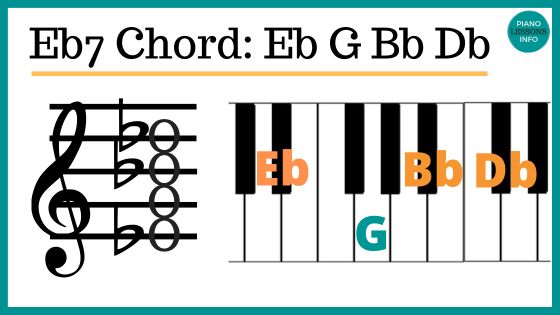
How to Play Eb7 Chord (Video)
This video will show you how to play the Eb7 chord on piano and what it should sound like.
Finger Placement & Playing the Eb7 Piano Chord
Now that we know which notes make up the Eb7 chord, let's discuss finger placement.
For the right hand:
- Place your thumb (1) on Eb.
- Your index finger (2) goes on G.
- The ring finger (4) will press Bb.
- Lastly, the pinky (5) plays Db.
For left-hand placement:
- The pinky (5) goes on Eb.
- Your ring finger (4) lands on G.
- The index finger (2) touches Bb.
- Finally, your thumb (1) presses Db.
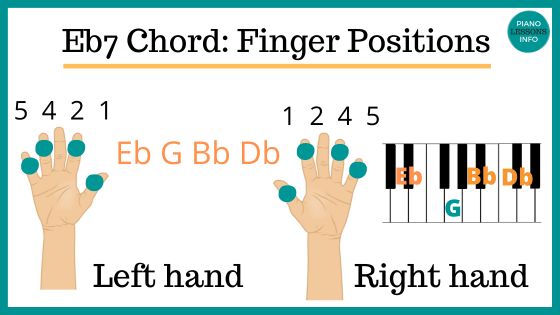
Remember, your hand should feel comfortable, not stretched or strained. If you've played 4 note chords before, you should be fine. However, if you haven't played that many, it may not feel too comfortable at first.
As you get familiar with the chord, try playing it in different octaves and inversions to explore its full range.
Eb7 and Music Theory: A Bit of Backstory
The 'E', 'b', and '7' in Eb7 aren't randomly chosen. They’re rooted in music theory. 'Eb' is the root note, the one on which the chord is based. The 7 is the chord title.
The chord formula for a seventh chord is the 1st, 3rd, 5th, and lowered 7th notes of the major scale.
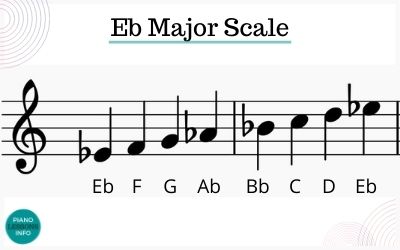
If you look at the Eb major scale, you can see that:
1 = Eb
3 = G
5 = Bb
7 = D which we lower down one semi-tone to be Db.
Adding the seventh note creates a rich, complex sound that is a step beyond the triad, making this chord very popular in blues, jazz, and pop music.
Eb7sus4 Piano Chord
Another chord that is popular is the Eb7sus or Eb7sus4 (they are the same).
This chord is made up of Ebsus4 or E flat suspended chord and then we add the minor 7th on top.
So the notes of Eb7sus4 are: Eb, Ab, Bb, Db.
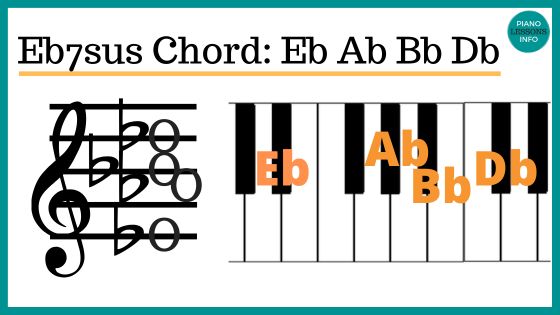
Exploring Eb7 Chord Progressions
A chord progression refers to a sequence of chords that are played in a piece of music. These progressions give music its harmonic movement.
For the Eb7 chord, there are several progressions that sound particularly pleasing to the ear. Here are a few you might like to experiment with:
- Eb7 - Ab7 - Db7 - Gb7: This progression is a cycle of fifths, a very common pattern in music. The richness of the seventh chords gives it a jazz-like feel.
- Bbm7 - Eb7 - AbM7: This progression incorporates a mix of major and minor chords, creating an interesting dynamic range of emotions.
- Ab7 - Cm7 - Eb7 - Db: This progression has a bit more complexity and tension, making it great for blues or rock music.
Remember, these are just starting points. Feel free to create your own progressions using the Eb7 chord.
Practising the Eb7 Chord
As with anything, practice makes perfect. Play the Eb7 chord in different progressions, mix it with other chords, and incorporate it into your songs. Remember to practice both the right and left-hand fingerings to gain agility and flexibility in both hands.
It's also a great idea to listen to pieces of music that use the Eb7 chord. Hearing the chord in context can give you a better understanding of how it functions musically and can inspire your compositions.
Wrapping It Up
And there you have it! We've decoded the Eb7 piano chord from its constituent notes to its finger placement, musical theory, and popular chord progressions. Like any new chord, it may feel a little tricky at first, but with a bit of practice, you'll be playing it smoothly in no time. So go ahead, get practising, and fill your music with the rich sound of the Eb7 chord.
Happy playing!
Free Download:
Ultimate Chord Cheat Sheet

Subscribe below and get free access to the (printable) Ultimate Chord Cheat Sheet.
Recent Articles
-
Piano Notes Chart
Nov 20, 23 10:21 PM
Find a piano notes chart for treble clef and bass clef notes as well as the different types of notes. -
D Chord on Piano + Diagram, How To & Theory
Oct 24, 23 12:20 AM
Learn how to play the D chord on piano with diagram, fingering, D/A, D/F# and a theory explainer. -
Diminished Piano Chords: Chart & How to Make Them
Oct 09, 23 09:23 PM
Learn the different diminished piano chords and how to make them. Here you'll find both a diminished chord chart and an explanation.
- Home
- Chord Chart
- Eb7 Piano Chord

